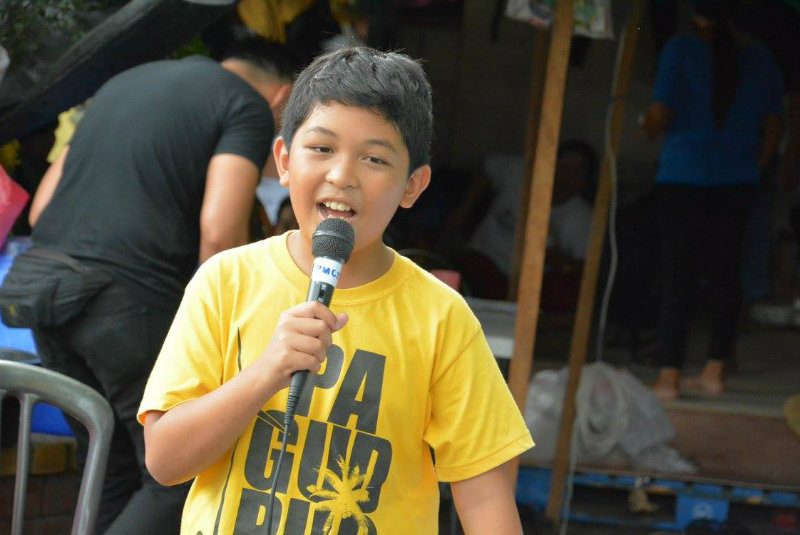SUMMARY
This is AI generated summarization, which may have errors. For context, always refer to the full article.

MANILA, Philippines – While other kids of his age are hooked on computer games or school work, 11-year-old Fidelino Atregenio Jr. instead chooses to join his father in rallying against giant mining companies, which he described as “walang kaawa-awa” or merciless.
At his age, he could be the youngest anti-mining advocate in the Philippines. (READ: Fast Facts: Mining in the Philippines)
His parents used to live in Manicani, a small island in Eastern Samar, but later decided to stay in Manila for good.
His father began tagging him along in anti-mining rallies in the city as early as when he was only two years old. Even if he did not grow up in the island, young Fidelino personally visits the area with his family almost every year.
At such a young age, he has already seen the bad effects of mining to Manicani and its residents. He lamented how the people of Manicani are dying because of the air and water pollution caused by mining activities.
“At the end of the day, they [mining companies] just destroy God’s creation and not loving it. Mining kills the people, the animals, and the water source. If mining continues in Manicani, the water source will be damned. A lot of trees are destroyed, which are good sources of food for the people,” Atregenio Jr. said in a phone interview.
He also noted how mining operations have forced some of the residents to leave the place and settle in another town or city. “They are just moving people away from their mines. Even if it’s just a small island, it’s going to be a big disaster for the world,” he continued.
He further noted that he wants to follow the footsteps of his father, and he wants to help him fight for Manicani and its people, regardless of his age.
“I just want to say that Manicani should be protected from mining. I want to help my Dad to fight for Manicani and its people. Even if you’re just 5 or 6 years old, as long as you fight for what is right, age really doesn’t matter. It is always nice to fight for what you stand for,” he added.
Climate change and mining
Manicani is a small island with a land area of 1,165 hectares and a population of more than 3,000 people scattered across four barangays. It falls within the territorial jurisdiction of the Municipality of Guiuan, Eastern Samar.
In 1992, the national government granted a Mineral Production Sharing Agreement(MPSA) to Hinatuan Mining Corporation(HMC) to mine nickel ore in the island. It practically covers almost the entirety of the Manicani, excluding only less than a hectare in its area of operation.
The 25-year contract should have expired last Oct 27, but to the dismay of anti-mining groups and residents, the LGUs in Manicani and the legislative bodies of the Municipality of Guiuan and the Province of Eastern Samar issued separate resolutions supporting HMC’s application to renew its MPSA covering the area.
However, another quarter of a century of harmful mining activities in Manicani destroys not only the island’s rich ecosystem; it also aggravates the effects of climate change in the small island.
Glenny Ymata from the Philippine Movement for Climate Justice (PMCJ) noted that the Philippines is among the top most vulnerable countries to climate change impacts, and with an average of 20 typhoons hitting the country each year, hundreds to thousands of lives are being lost and billions of pesos of properties and infrastructures are getting damaged beyond repair.
When supertyphoon Yolanda (internationally known as Haian) barreled through the Visayas in 2013, it made its first landfall in Guiuan. This left a massive trail of destruction in the islands of Manicani and nearby Homonhon—leaving a death toll of over 6,300.
Mining
“Mining is responsible for making our communities weak and susceptible to climate impacts. Thus, addressing climate change crisis would necessitate in renewing our lands, forests, and seas,” said Ymata in a statement.
Lawyer Avril De Torres from Center for Energy, Ecology, and Development (CEED) added that the Philippines should completely prohibit mining operations within its territory. “Mining exacerbates our vulnerability because it removes our natural barriers to typhoons, floodings, landslides, and droughts,” said De Torres.
As a response to the renewed threat to pursue large-scale mining operations in Manicani, Manicani residents under Protect Manicani Island Society (PROMISI) and Save Manicani Movment (SAMAMO) staged protest actions supported by the Diocese of Borongan and other support organizations.
Early in November 7, around 30 Manicani and Homonhon residents staged a four-day caravan from Guiuan to Metro Manila, which culminated in a camp out at the DENR Central Office in Quezon City, heightening the protest against large-scale mining in Guiuan and the lifting of the ban on open pit mining.
According to Jaybee Garganera of Alyansa Tigil Mina(ATM), another 25 years of large-scale mining operations in Manicani would be catastrophic to both the people and the environment because of the long-time resistance from the island folks and the threat of heightened natural calamity caused by climate change.
Garganera also added that changing climatic conditions can only worsen the hell hole that Manicani has now become. – Rappler.com
Roy Joseph R. Roberto is a Philippine Youth Ambassador of Goodwill to the 42nd Ship for Southeast Asian and Japanese Youth Program (SSEAYP). He recently participated in Climate Tracker’s Southeast Asia Workshop on Climate Journalism. Climate Tracker is one of the biggest hubs of online writers and journalists globally, advocating for climate action and clean energy.
Add a comment
How does this make you feel?
There are no comments yet. Add your comment to start the conversation.